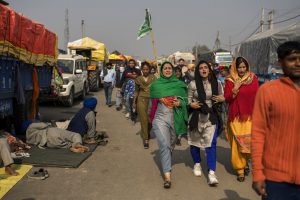For the past six years, Indian Prime Minister Narendra Modi’s passionate supporters have built and nurtured an impressive personality cult, casting the prime minister as a strongman leader who “gets things done.” The campaign has landed two historic electoral victories so far. To many middle-class Indians, Modi’s strongman image is attractive, because they believe that only a strongman leader can deliver the important but politically difficult reforms necessary to liberalize the Indian economy.
Yet, whenever he has attempted to be an economic reformer, all these things – the personality cult, the strongman tendencies, and the passionate support base – have turned out to be Modi’s bane, not his boon.
Take as an example the ongoing farmer protests that have ravaged parts of north India in recent days. The controversy began in September, when the Modi government introduced an ordinance to liberalize India’s farm economy. While farmers in many states were previously compelled to sell their produce only to licensed traders in state-run market yards, the newly introduced laws now allowed them to sell crops to anybody.
To be sure, this is a sensible reform. India’s farm economy has long been crippled by cartels that dominate the state-run market yards. Far removed from the bustling consumer markets of the towns and cities, the cartels have distorted the market, offering farmers a minimal price while selling the same produce for huge profits in the cities. The new laws will now permit farmers to access consumers directly, provided further initiatives are undertaken to build market linkages.
Yet, despite these expected benefits, farmers in the states of Punjab, Haryana, and elsewhere have been dissenting against the laws for weeks, fearing that the reforms will soon corporatize the farming sector and take away vital price support.
Under the tightly regulated system that India currently has, farmers can sell their produce to government agencies at the Minimum Support Price (MSP) – a measure which insures farmers against heavy losses when the market turns against them. The protestors argue that liberalizing the farm sector will eventually result in the end of government procurement and the scrapping of the MSP scheme.
But as economist Vivek Kaul recently pointed out, this is highly unlikely. The Indian government runs a vast public distribution system, mandated under the Food Security Act, which needs to be stocked through direct procurement of crops. And during the COVID-19 pandemic, the government has depended heavily on this system to provide relief. The laws themselves, therefore, do not get rid of the state-run market yards or the price support mechanism.
The government has said that the protestors are being misled by the opposition. Yet, far from countering that by holding press conferences or opening dialogue, the government cracked down. Police in Delhi started using water cannons and tear gas to disperse protestors. At one point, they contemplated converting the city’s stadiums into makeshift prisons to incarcerate them.
Meanwhile, functionaries and supporters of the ruling Bharatiya Janata Party (BJP) began an aggressive smear campaign on social media. The head of the BJP’s Information Technology cell claimed that the protestors were Maoist rebels and Sikh secessionists. The chief minister of Haryana, also from the BJP, echoed that allegation. Several others shared fake videos supporting those claims.
If Modi wishes to reform the Indian economy, he will have to publicly rebuke such rhetoric. For reforms to succeed in a vast and diverse democracy like India, aggression does not work. There has to be a broad consensus, to bring multiple players – including the intended beneficiaries – onboard, so that all stakeholders are able to plan and act as needed for the reforms to succeed. All this needs widespread debate and discussion, including multiple rounds of questioning and clarification with the government, before the reforms are finally rolled out.
Yet, none of this has ever happened. When these farm reforms were passed, they were brought out by circumventing the parliament – in the form of an ordinance. The government also removed the Question Hour during the truncated monsoon session of Parliament this year, sparking fears that Parliament was now no more than a mere notice board for policies and laws that have already been concluded beforehand. And the prime minister himself has not held a single press conference in six years.
This strongman-style “shock and awe” approach, including aggressive propaganda against critics, has hindered the Modi government’s ability to implement any reform meaningfully. The government has been unable to engage reasonably with the public, convey its intentions, or issue any coherent guidelines. And the problem has plagued all policies, both good and bad, from the ill-conceived demonetization to the vastly confusing Goods and Services Tax, which left businessmen, investors, and accountants all at sea.
In a vast and diverse country like India, successful reform cannot be achieved through strongman politics. To fix its economy, India needs more democracy, not less.

































